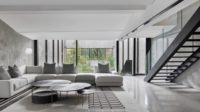A Skate Park at Parc Olympique Cements Montreal’s Reputation as a ‘Shredding’ Paradise
.jpg?1721312654)
Parc Olympique Skatepark, Montreal. Photo © Julien Lauzon
Architects & Firms
In 1966, the short documentary film The Devil’s Toy (Rouli-roulant) took to the streets to chronicle the dawn of skateboarding in Montreal. Teenagers in turtlenecks, thick sweaters, and trench coats couldn’t look more innocent as they careen down sidewalks and Mont-Royal Park paths, no doubt exhilarated by the speed and freedom. But the police crack down, absconding with four boards and telling the kids that they can retrieve them at an indoor ice rink. When they do, the narrator, with a baritone fit for a war documentary, tells viewers: “The battle was won. For the moment, we are safe. But beware: The youth of the world is on the move and their aim is to take over.”
Indeed, skateboarders did take over Montreal, which is considered the capital of the scene in Canada and has long been a draw for international enthusiasts. Though the landscape has not always been skate-friendly—advocates have complained of the lack of functional, free, outdoor skate parks and provincial law has prohibited skateboarding on city streets since 1986—skaters have recently gained new parks, inclusive community groups, the right to use bike paths, and widespread support.
.webp)
.webp)
Photos © Julien Lauzon
One of the wins is certainly the new Parc Olympique Skatepark, designed by Canadian firm Lemay. Built for the 1976 Summer Olympics, the larger park was designed by French architect Roger Taillibert, who conceived the city’s famous inclined tower that hovers at a 45-degree angle over a donut-shaped multi-purpose stadium (dubbed “The Big-O’). In recent years, Lemay has been working on a master plan for the 150-acre park, along with interventions to create a more sustainable, resilient, and functional event space. “The park is immense, it has a lot of heritage, and it’s been going through a reinvention,” says Patricia Lussier, a landscape architect and design director at Lemay.
The skate park is a piece of that puzzle, built on an esplanade called Sector 900. In 2019, Vans, the California-based apparel and shoe brand known for popularizing skateboarding sneakers in the 1970s, built a bowl west of Parc Olympique’s stadium for a one-off competition. In 2020, Lemay’s brief from park stakeholders was to build a street course surrounding the bowl that would be accessible and free year-round. “It was important for the park to be a good citizen and open to the community that surrounds the space,” says Lemay landscape architect Carlos Santibanez. The small, round site was maximized, so that every element is skateable.
.webp)
.webp)
Photos © Julien Lauzon
The Lemay team wanted to stay true to Taillibert’s original design for Parc Olympique, which included elliptical, curving forms in the layout of the site plan as well as in the massing of its daring concrete structures. Sleek, curved swaths of all-season C1 concrete (often used for parking decks or marine structures exposed to water) elegantly slope down to the existing bowl, while pops of red paint accentuate metal rails and the edges of concrete benches. Lemay ensured that views of The Big-O were primary from all parts of the park.
Working with consultants from design and build studio California Skateparks and local pro skateboarder Charles Deschamps, Santibanez was able to ensure that the park included elements that could be used by both beginners and seasoned skaters alike. “They validated our gestures and intent, and all of the clearances,” he says, noting that the joints and radius of every curve in the concrete are critically important for a skate park. The concrete itself was “shot like a paint gun,” as opposed to poured, and hand-troweled to create a smooth, silky finish. Organic shapes are fiber-reinforced to achieve the shapes the architects intended, and for added durability. Lemay also reactivated water fountains that had been part of Taillibert’s original design for Sector 900.
A future phase will improve the surrounding greenspace and increase the amount of shade trees on site. While not part of Lemay’s scope, original modular benches by French architect and designer Francois Dallegret were recreated for the site.
.webp)
Photo © Julien Lauzon
Santibanez noted that site-specific murals were painted at the skate park since the firm’s professional photography was taken, and street artists have followed with tags. “You can skate everywhere, and you can make art everywhere. The concrete is like a big canvas,” he said.




